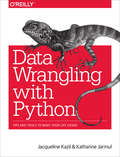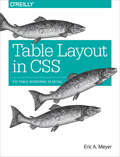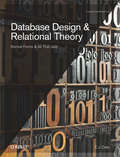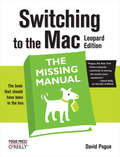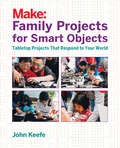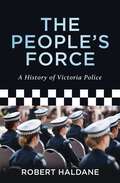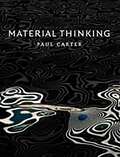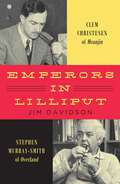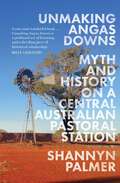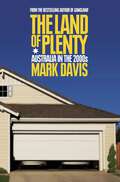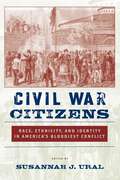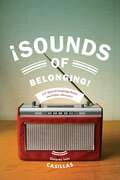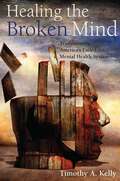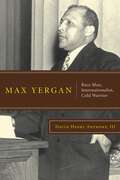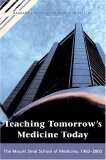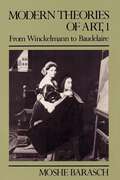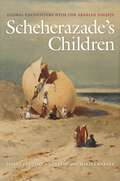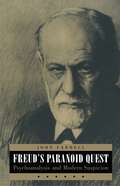- Table View
- List View
Data Wrangling with Python: Tips and Tools to Make Your Life Easier
by Katharine Jarmul Jacqueline KazilHow do you take your data analysis skills beyond Excel to the next level? By learning just enough Python to get stuff done. This hands-on guide shows non-programmers like you how to process information that’s initially too messy or difficult to access. You don't need to know a thing about the Python programming language to get started.Through various step-by-step exercises, you’ll learn how to acquire, clean, analyze, and present data efficiently. You’ll also discover how to automate your data process, schedule file- editing and clean-up tasks, process larger datasets, and create compelling stories with data you obtain.Quickly learn basic Python syntax, data types, and language conceptsWork with both machine-readable and human-consumable dataScrape websites and APIs to find a bounty of useful informationClean and format data to eliminate duplicates and errors in your datasetsLearn when to standardize data and when to test and script data cleanupExplore and analyze your datasets with new Python libraries and techniquesUse Python solutions to automate your entire data-wrangling process
Table Layout in CSS: CSS Table Rendering in Detail
by Eric A. MeyerIsn’t table layout something web designers want to avoid? Yes, but rather than use tables for layout, this book is about the ways that tables themselves are laid out by CSS, a process more complicated than it appears. This concise guide takes you on a deep dive into the concepts necessary for understanding CSS and tables in your web layout, including table formatting, cell alignment, and table width.Short and deep, this book is an excerpt from the upcoming fourth edition of CSS: The Definitive Guide. When you purchase either the print or the ebook edition of Table Layout in CSS, you’ll receive a discount on the entire Definitive Guide once it’s released. Why wait? Make your web pages come alive today.You’ll explore:Formatting—learn how elements such as display values, anonymous objects, and table layers relate to each other when you assemble CSS tablesCell border appearance—understand two distinct approaches (the separated model and the collapsed model) that govern how (or if) borders mergeTable sizing—determine table width by using either a fixed- or automatic-width layout, and learn how heights are calculated
Database Design and Relational Theory: Normal Forms and All That Jazz
by C. J. DateWhat makes this book different from others on database design? Many resources on design practice do little to explain the underlying theory, and books on design theory are aimed primarily at theoreticians. In this book, renowned expert Chris Date bridges the gap by introducing design theory in ways practitioners can understand—drawing on lessons learned over four decades of experience to demonstrate why proper database design is so critical in the first place.Every chapter includes a set of exercises that show how to apply the theoretical ideas in practice, provide additional information, or ask you to prove some simple theoretical result. If you’re a database professional familiar with the relational model, and have more than a passing interest in database design, this book is for you.Questions this book answers include:Why is Heath’s Theorem so important?What is The Principle of Orthogonal Design?What makes some JDs reducible and others irreducible?Why does dependency preservation matter?Should data redundancy always be avoided? Can it be?Databases often stay in production for decades, and careful design is critical for avoiding subtle errors and processing problems over time. If they’re badly designed, the negative impacts can be incredibly widespread. This gentle introduction shows you how to use important theoretical results to create good database designs.
Switching to the Mac: Leopard Edition (Missing Manual)
by David PogueIs Windows giving you pause? Ready to make the leap to the Mac instead? There has never been a better time to switch from Windows to Mac, and this incomparable guide will help you make a smooth transition. New York Times columnist and Missing Manuals creator David Pogue gets you past three challenges: transferring your stuff, assembling Mac programs so you can do what you did with Windows, and learning your way around Mac OS X.Why is this such a good time to switch? Upgrading from one version of Windows to another used to be simple. But now there's Windows Vista, a veritable resource hog that forces you to relearn everything. Learning a Mac is not a piece of cake, but once you do, the rewards are oh-so-much better. No viruses, worms or spyware. No questionable firewalls, inefficient permissions, or other strange features. Just a beautiful machine with a thoroughly reliable system. And if you're still using Windows XP, we've got you covered, too.If you're ready to take on Mac OS X Leopard, the latest edition of this bestselling guide tells you everything you need to know:Transferring your stuff -- Moving photos, MP3s, and Microsoft Office documents is the easy part. This book gets you through the tricky things: extracting your email, address book, calendar, Web bookmarks, buddy list, desktop pictures, and MP3 files.Re-creating your software suite -- Big-name programs (Word, Photoshop, Firefox, Dreamweaver, and so on) are available in both Mac and Windows versions, but hundreds of other programs are available only for Windows. This guide identifies the Mac equivalents and explains how to move your data to them.Learning Leopard -- Once you've moved into the Mac, a final task awaits: Learning your way around. Fortunately, you're in good hands with the author of Mac OS X: The Missing Manual, the #1 bestselling guide to the Macintosh.Moving from Windows to a Mac successfully and painlessly is the one thing Apple does not deliver. Switching to the Mac: The Missing Manual, Leopard Edition is your ticket to a new computing experience.
The Art of Application Performance Testing: From Strategy to Tools
by Ian MolyneauxBecause performance is paramount today, this thoroughly updated guide shows you how to test mission-critical applications for scalability and performance before you deploy them—whether it’s to the cloud or a mobile device. You’ll learn the complete testing process lifecycle step-by-step, along with best practices to plan, coordinate, and conduct performance tests on your applications.Set realistic performance testing goalsImplement an effective application performance testing strategyInterpret performance test resultsCope with different application technologies and architecturesUnderstand the importance of End User Monitoring (EUM)Use automated performance testing toolsTest traditional local applications, web applications, and web servicesRecognize and resolves issues often overlooked in performance testsWritten by a consultant with over 15 years’ experience with performance testing, The Art of Application Performance Testing thoroughly explains the pitfalls of an inadequate testing strategy and offers a robust, structured approach for ensuring that your applications perform well and scale effectively when the need arises.
Family Projects for Smart Objects: Tabletop Projects That Respond to Your World
by John Keefe"The Internet of Things" is the new buzzphrase, but what is it? A toaster that texts? The fitness band on your wrist? The camera in an infant's room? Sure, it's all of those things. But it's also your phone: an ultra-sophisticated sensor and communications system in your pocket or purse--capable of tracking your steps, capturing an image, or calling an Uber. And it is actually not hard or expensive to make a sensing, communicating object yourself. Doing so can be rewarding, fun, and even useful. This book teaches the basics of building sensors and communicating objects through a series of practical, demonstrative, and fun activities.
Associations: Creative Practice and Research
by James OliverAssociations is a collection of essays and reflections on creative practice and research. It presents some contemporary accounts and reflections on doing research for, through and with creative practices, particularly in the higher education sector. The overview of the book includes art and design and other creative practices-as-research intersections and will be particularly interesting to postgraduate researchers and emerging researchers. It is not a methods text, but it is oriented towards methodological thinking and the social and structural situations of creative practice and research. Contributors include: Gene Bawden; Barbara Bolt; Danny Butt; Tania Ca�as; Aaron Corn; Anne Douglas; Mick Douglas; L�uli Eshrāghi; Ross Gibson; Lisa Grocott; Anna Hickey-Moody; Lucas Ihlein; Lyndal Jones; Hannah Korsmeyer; Julienne van Loon; Lachlan MacDowall; Brian Martin; James Oliver; Kate Pahl; Sarah Pink; Steve Pool; Amanda Ravetz; Ricardo Sosa; Naomi Stead; John Vella; Jessica Wilkinson
People's Force
by Robert HaldaneSince its formation in 1853 the story of the Victoria Police has been interwoven with Victorian social and political history. Following the amalgamation of seven separate and distinct police agencies in the colony, the resultant unified body was the first of its kind in Australia. Many events have shaped its development: the gold rushes, the Clunes riot, the Kelly outbreak, the maritime strikes, the coming of the motor car, the police strike, both world wars and the Vietnam war protests, the gangland wars, Black Saturday bushfires and the use of DNA to solve crimes all formed part of this mosaic. This revised edition of The People's Force, containing a new chapter and new illustrations, brings the history up to date to include a decade that has been full of turbulent change. The new chapter examines the administrations of Neil Comrie, Christine Nixon, Simon Overland, Ken Lay and Graham Ashton. New material deals with Silk and Miller, and other police shootings, the growth of terrorism, gender issues, racism and domestic violence. Written as a 'warts and all' history of the Victoria Police with the support and encouragement of the then Chief Commissioner S. I. ('Mick') Miller, who wanted a proper objective history of the force, not a public relations exercise. This third edition is owed largely to Miller's encouragement and his desire to see the history updated.
Reboot: A Democracy Makeover to Empower Australia's Voters
by Richard WalshIf you want real change, change the system.Reboot offers a tantalising glimpse of a better future, where politicians work directly and closely with those who voted for them.Utopian? Disillusional? Richard Walsh makes a tour de force argument for doing away with the senate, embracing a republic and having a government where the prime minister and ministers are the best people in the country, not just chosen from the politicians who sit in the parliament.
Speechless: A Year In My Father's Business: Updated Edition
by James ButtonJames Button spent a year writing speeches for Kevin Rudd. Before that, he reported on politics as a highly regarded journalist for Fairfax. But James also has politics in the blood: his father was the diminutive but larger-than-life Senator John Button, who was a minister in the Hawke and Keating governments. Growing up, James watched a roll-call of political luminaries debating the fate of the Labor Party. He saw great victories and defeats at close hand. He believes both his father and his family paid a heavy price for politics. Speechless is James' highly personal account of a year working in Canberra, seen from both the inside and the outside. It's told through his experience of Kevin Rudd's failure to tell his story, and how this helped destroy his prime ministership. It also reflects on how far the Labor Party has moved from the idealism and pragmatism of his father's generation. He ends on a note of hope for the Party's revival.
Private Lives, Public History
by Anna ClarkThe past is consumed on a grand scale: popularised by television programs, enjoyed by reading groups, walking groups, historical societies and heritage tours, and supported by unprecedented digital access to archival records. Yet our history has also become the subject of heated political contest and debate. In Private Lives, Public History, historian Anna Clark explores how our personal pasts intersect with broader historical questions and debates. Drawing on interviews with Australians from five communities around the country, she uncovers how we think about the past in the context of our local and intimate stories, and the role history plays in our lives.
Material Thinking
by Paul CarterMaterial Thinking is a ground-breaking book for artists, and for those who study or teach in the arts. Author and artist Paul Carter provides an intimate, first-hand account of how ideas are turned into works, and how the material thinking these artworks embody produces new understandings about ourselves, our histories and the culture we inhabit. Taking as his subject several artistic collaborations which resulted in performances, exhibitions or videos, Carter explores how each unfolded. In the course of this analysis he constructs a philosophy of how the practice and theory of making art are interconnected, a philosophy powerful enough to provide an intellectual underpinning for the new, and still developing, field of creative research. ---- 'Here is startling, practical erudition. Prodigious book-learning is laced with real understanding of what it means to make art, to infuse sullen matter with something rousing, delicate and vital.' -Ross Gibson, Research Professor of New Media & Digital Culture, UTS 'For twenty years I have campaigned for, and conducted, research in the medium of architecture itself, research that is not "about" architecture but "of" if. Carter begins by drawing the same distinction, but his ambition is greater: he seeks to explore and define research in the zones where creative mediums shade into each other. To work in a zone is to collaborate with practitioners who are centred on their medium of practice. Carter posits a new role for the critic, not outside looking in, not "about" practice but inside, "of", and pushing practitioners towards the liminal, and thus toward the innovative.' -Leon van Schaik, Innovation Professor of Architecture, RMIT
Emperors in Lilliput: Clem Christesen of Meanjin and Stephen Murray-Smith of Overland
by Jim Davidson'Lilliput', in this dual biography, is the world of literary magazines in Australia between the 1940s and the 1980s. Here Clem Christesen and Stephen Murray-Smith, of the journals Meanjin and Overland, were determined, driven visionaries. Both were very human-and occasionally bruised-believers in and workers for a better nation. The book ranges from before the Menzies era and the Cold War, through the Whitlam period and beyond to the challenges of the 1980s. It shows how the editors constantly aimed for a culture more liberal, diverse and developed than the one then prevailing. Their publications may have lacked resources and economic return, but they nonetheless possessed authority, regularly providing stimulation for their readers and for the nation. In finely wrought detail, Jim Davidson-the second editor of Meanjin-traces the commitment of Christesen and Murray-Smith to this ambitious cultural project and how it attracted many of the key writers and thinkers of those years. There are pen portraits of many of them, as the reader is taken behind the scenes. Emperors in Lilliput exhibits the enlightened creative spirit animating these journals at their best. It is at once captivating biography and rich social history.
Unmaking Angas Downs: Myth and History on a Central Australian Pastoral Station
by Shannyn PalmerSome stories dominate how we see and interpret a place, while others are obscured from view. Angas Downs is a pastoral station in Central Australia, but pastoralism is only a fraction of what has happened there. Like all places it has accrued people and stories, in multiple layers, over time. Listening to Tjuki Tjukanku Pumpjack and Sandra Armstrong, two Anangu with deep and abiding connections to Angas Downs, a very different kind of place emerges from that conjured in myths and histories of pioneers and pastoralists that have shaped understandings of the past in Australia, particularly in the Northern Territory. Unmaking Angas Downs traces a history of colonisation in Central Australia by tracking the rise and demise of a rural enterprise across half a century, as well as the complex and creative practices that transformed a cattle station into Country. It grapples with the question of how people experience profound dislocation and come to make a place for themselves in the wake of rupture. Angas Downs emerges as a place of dynamic interaction and social life - not only lived in, but also made by Anangu.
Struggletown: Public and Private Life in Richmond 1900–1965
by Janet McCalman'The old Struggletowners, if they could see it now, would not believe their eyes.' In Struggletown, Janet McCalman takes us into the inner-city industrial working-class suburb of Richmond, in Melbourne, before the gentrification of the 1970s. This is a narrative richly informed by the voices and memories of those who lived there during this time - the Struggletowners themselves - as well as by McCalman's familiarity with the objects, buildings and topography of their physical environment and her impressive awareness of larger social forces, structures and patterns. As urban life continues to develop in new directions and complex human and political relations suggest new futures, the difficulty and necessity of remembering, now, also lends this classic work a palpable new relevance.
Land Of Plenty: Australia In The 2000s
by Mark Davis'There is an Australian dream that is collective. It goes to the roots of what it means to be Australian, since it's imprinted in Australia's history, the collective acts of its peoples, their attitudes, their gestures, what and how they eat, how they spend their leisure time, and the way such things reflect upon and derive from who they are.' In The Land of Plenty, Mark Davis argues that this dream has been forsaken. Over the past few decades Australians have felt the ground shift beneath their feet. Many people are asking why Australia is no longer the egalitarian place it once was. While the airwaves sing and newspaper front pages burst with news of how prosperous Australians are, many people wonder why they are working harder and longer, for so little, while important social agendas have fallen by the wayside. The Land of Plenty is at once a devastating record of the changes that have taken place in Australian society since the 1980s, and a goldmine of ideas for change. Insightful, provocative and thoroughly original, The Land of Plenty is a manifesto for our times.
Civil War Citizens: Race, Ethnicity, and Identity in America’s Bloodiest Conflict
by Susannah J. UralAt its core, the Civil War was a conflict over the meaning of citizenship. Most famously, it became a struggle over whether or not to grant rights to a group that stood outside the pale of civil-society: African Americans. But other groups--namely Jews, Germans, the Irish, and Native Americans--also became part of this struggle to exercise rights stripped from them by legislation, court rulings, and the prejudices that defined the age.Grounded in extensive research by experts in their respective fields, Civil War Citizens is the first volume to collectively analyze the wartime experiences of those who lived outside the dominant white, Anglo-Saxon Protestant citizenry of nineteenth-century America. The essays examine the momentous decisions made by these communities in the face of war, their desire for full citizenship, the complex loyalties that shaped their actions, and the inspiring and heartbreaking results of their choices-- choices that still echo through the United States today. Contributors: Stephen D. Engle, William McKee Evans, David T. Gleeson, Andrea Mehrländer, Joseph P. Reidy, Robert N. Rosen, and Susannah J. Ural.
Sounds of Belonging: U.S. Spanish-language Radio and Public Advocacy (Critical Cultural Communication #33)
by Dolores Ines CasillasHow Spanish-language radio has influenced American and Latino discourse on key current affairs issues such as citizenship and immigration. Winner, Book of the Year presented by the American Association of Hispanics in Higher EducationHonorable Mention for the 2015 Latino Studies Best Book presented by the Latin American Studies AssociationThelast two decades have produced continued Latino population growth, and markedshifts in both communications and immigration policy. Since the 1990s, Spanish-language radio has dethroned English-language radio stations in major citiesacross the United States, taking over the number one spot in Los Angeles,Houston, Miami, and New York City. Investigating the cultural and politicalhistory of U.S. Spanish-language broadcasts throughout the twentieth century, Soundsof Belonging reveals how these changes have helped Spanish-language radiosecure its dominance in the major U.S. radio markets.Bringing together theories on the immigration experience withsound and radio studies, Dolores Inés Casillas documentshow Latinos form listening relationships with Spanish-language radioprogramming. Using a vast array of sources, from print culture and industryjournals to sound archives of radio programming, she reflects on institutionalgrowth, the evolution of programming genres, and reception by the radioindustry and listeners to map the trajectory of Spanish-language radio, fromits grassroots origins to the current corporate-sponsored business it hasbecome. Casillas focuses on Latinos’ use of Spanish-language radio to helpnavigate their immigrant experiences with U.S. institutions, for example inbroadcasting discussions about immigration policies while providing anonymityfor a legally vulnerable listenership. Sounds of Belonging proposes thatdebates of citizenship are not always formal personal appeals but a collectiveexperience heard loudly through broadcast radio.
Healing the Broken Mind: Transforming America’s Failed Mental Health System
by Timothy A. KellyFew afflictions are as frightening or as heartbreaking as mental illness. It may be a topic that many would prefer to sweep under the rug, but it is a fact of life that we as a society can and must face. We have come a long way over the past few decades in our understanding of mental illness and its potential treatments. Yet, tragically, many across the country who struggle with serious mental illness are unable to find effective, quality medical treatment. As a federal commission on mental health concluded, the system of care is in shambles. But why? And how do we fix it?Timothy A. Kelly, former Commissioner of Virginia’s Department of Mental Health, Retardation, and Substance Abuse, brings his three decades of experience as mental health commissioner, psychology professor, and clinician to bear in confronting this crisis in America’s mental health care system. In clear and accessible terms, he exposes the weaknesses in the current system, examining how and why one of the world’s richest and most advanced countries has allowed its most vulnerable citizens to be victimized by the very system designed to help them.Armed with the latest statistics, a lifetime of experience, and heartrending life stories, Kelly argues that the patchwork of care traditionally employed to treat mental illness is simply not up to the task, and that what we need is profound, fundamental, and system-wide change. He then goes on to provide an easy-to-follow road map for achieving lasting transformation, centered on five recommendations for creating a truly effective mental health system of care that enables patients to achieve a lasting recovery.Mental illness is not going to just go away, but Kelly prescribes a comprehensive plan to make treatment accessible and effective so that those who suffer can rejoin their families and their communities. He shows how a transformed system of community-based care allows those with serious mental illness to finally be able to go home.
Max Yergan: Race Man, Internationalist, Cold Warrior
by David Henry Anthony, IIIIn his long and fascinating life, black activist and intellectual Max Yergan (1892-1975) traveled on more ground—both literally and figuratively—than any of his impressive contemporaries, which included Adam Clayton Powell, Paul Robeson, W.E.B. Du Bois, and A. Phillip Randolph. Yergan rose through the ranks of the "colored" work department of the YMCA, and was among the first black YMCA missionaries in South Africa. His exposure to the brutality of colonial white rule in South Africa caused him to veer away from mainstream, liberal civil rights organizations, and, by the mid-1930s, into the orbit of the Communist Party. A mere decade later, Cold War hysteria and intimidation pushed Yergan away from progressive politics and increasingly toward conservatism. In his later years he even became an apologist for apartheid.Drawing on personal interviews and extensive archival research, David H. Anthony has written much more than a biography of this enigmatic leader. In following the winding road of Yergan’s life, Anthony offers a tour through the complex and interrelated political and institutional movements that have shaped the history of the black world from the United States to South Africa.
Teaching Tomorrow's Medicine Today: The Mount Sinai School of Medicine, 1963-2003
by Arthur H. Aufses Jr. Barbara NissFrom Mount Sinai Department of Surgery chairman Arthur H. Afuses, Jr. and archivist Barbara Nuss, an instructional account of Mount Sinai's teaching methodsThe Mount Sinai Hospital was founded in 1852 as the Jews’ Hospital in the City of New York, but more than a century would pass before a school of medicine was created at Mount Sinai. In Teaching Tomorrow’s Medicine Today, Arthur H. Aufses, Jr., chairman of Mount Sinai's Department of Surgery, and archivist Barbara Niss chronicle the development of the medical school from its origins in the 1960s to the current leadership.The authors examine the social forces that compelled the world-renowned hospital to remake itself as an academic medical center, revealing the school's departure from and subsequent return to its founders' original vision. In addition to a compelling history of each of Mount Sinai’s departments, Teaching Tomorrow’s Medicine Today describes the school’s methods for providing both graduate or resident training and post-graduate physician education.Recognizing Mount Sinai’s central mission as a teaching institution, the authors close their account with perspectives of alumni and current students.
Modern Theories of Art 1: From Winckelmann to Baudelaire
by Moshe BaraschThis is an analytical survey of the thought about painting and sculpture as it unfolded from the early eighteenth to the mid-nineteenth centuries. This was the period during which theories of the visual arts, particularly of painting and sculpture, underwent a radical transformation, as a result of which the intellectual foundations of our modern views on the arts were formed. Because this transformation can only be understood when seen in a broad context of cultural, aesthetic, and philosophical developments of the period, Moshe Barasch surveys the opinions of the artists, and also treats in some detail the doctrines of philosophers, poets, and critics. Barasch thus traces for the reader the entire development of modernism in art and art theory.
Scheherazade's Children: Global Encounters with the Arabian Nights
by Philip F. Kennedy and Marina WarnerScheherazade’s Children gathers together leading scholars to explore the reverberations of the tales of the Arabian Nights across a startlingly wide and transnational range of cultural endeavors. The contributors, drawn from a wide array of disciplines, extend their inquiries into the book’s metamorphoses on stage and screen as well as in literature—from India to Japan, from Sanskrit mythology to British pantomime, from Baroque opera to puppet shows. Their highly original research illuminates little-known manifestations of the Nights, and provides unexpected contexts for understanding the book’s complex history. Polemical issues are thereby given unprecedented and enlightening interpretations. Organized under the rubrics of Translating, Engaging, and Staging, these essays view the Nights corpus as a uniquely accretive cultural bundle that absorbs the works upon which it has exerted influence. In this view, the Arabian Nights is a dynamic, living and breathing cross-cultural phenomenon that has left its mark on fields as disparate as the European novel and early Indian cinema. While scholarly, the writers’ approach is also lively and entertaining, and the book is richly illustrated with unusual materials to deliver a sparkling and highly original exploration of the Arabian Nights’ radiating influence on world literature, performance, and culture.
Freud's Paranoid Quest: Psychoanalysis and Modern Suspicion
by John C. FarrellFreud's Paranoid Quest is an exceptionally broad-ranging and well-written book....Whether or not one agrees with certain of his arguments and assessments, one must acknowledge the remarkable intelligence that is displayed on nearly every page.--Louis Sassauthor of Madness and Modernism and The Paradoxes of Delusion John Farrell's Freud's Paranoid Quest is the most trenchant, exhilarating and illuminating book I have encountered in many years. [The book] should be pondered not just by all students of Freud's thought but by everyone who senses that 'advanced modernity' has by now outstayed its welcome.--Frederick CrewsUniversity of California, Berkeley In Freud's Paranoid Quest, John Farrell analyzes the personality and thought of Sigmund Freud in order to give insight into modernity's paranoid character and into the true nature of Freudian psychoanalysis. John Farrell's Freud is not the path-breaking psychologist he claimed to be, but the fashioner and prisoner of a total system of suspicion. The most gifted of paranoids, Freud deployed this system as a self-heroizing myth and a compelling historical ideology.
Social Death: Racialized Rightlessness and the Criminalization of the Unprotected (Nation of Nations #7)
by Lisa Marie CachoWinner of the 2013 John Hope Franklin Book Prize presented by the American Studies AssociationA necessary read that demonstrates the ways in which certain people are devalued without attention to social contextsSocial Death tackles one of the core paradoxes of social justice struggles and scholarship—that the battle to end oppression shares the moral grammar that structures exploitation and sanctions state violence. Lisa Marie Cacho forcefully argues that the demands for personhood for those who, in the eyes of society, have little value, depend on capitalist and heteropatriarchal measures of worth.With poignant case studies, Cacho illustrates that our very understanding of personhood is premised upon the unchallenged devaluation of criminalized populations of color. Hence, the reliance of rights-based politics on notions of who is and is not a deserving member of society inadvertently replicates the logic that creates and normalizes states of social and literal death. Her understanding of inalienable rights and personhood provides us the much-needed comparative analytical and ethical tools to understand the racialized and nationalized tensions between racial groups. Driven by a radical, relentless critique, Social Death challenges us to imagine a heretofore “unthinkable” politics and ethics that do not rest on neoliberal arguments about worth, but rather emerge from the insurgent experiences of those negated persons who do not live by the norms that determine the productive, patriotic, law abiding, and family-oriented subject.
